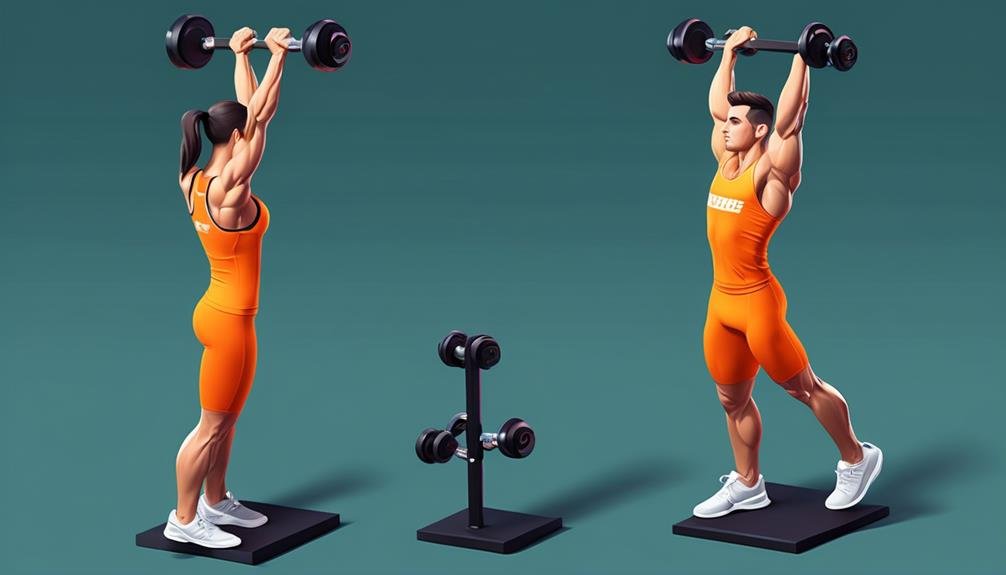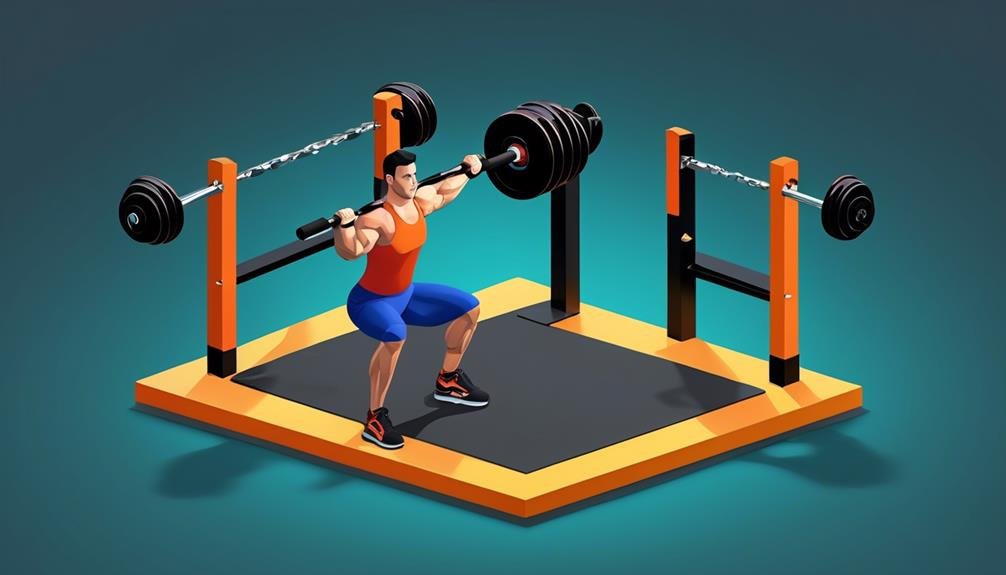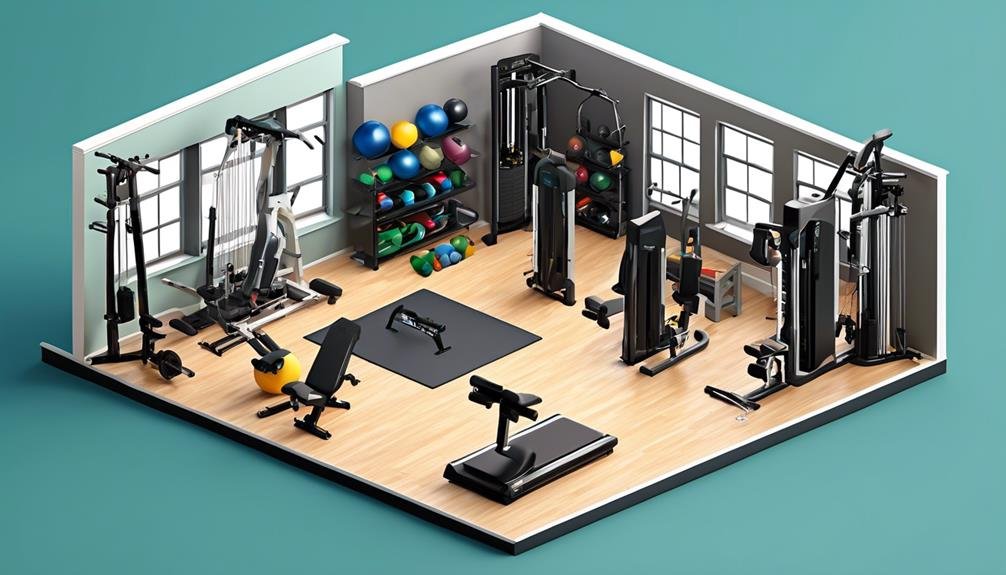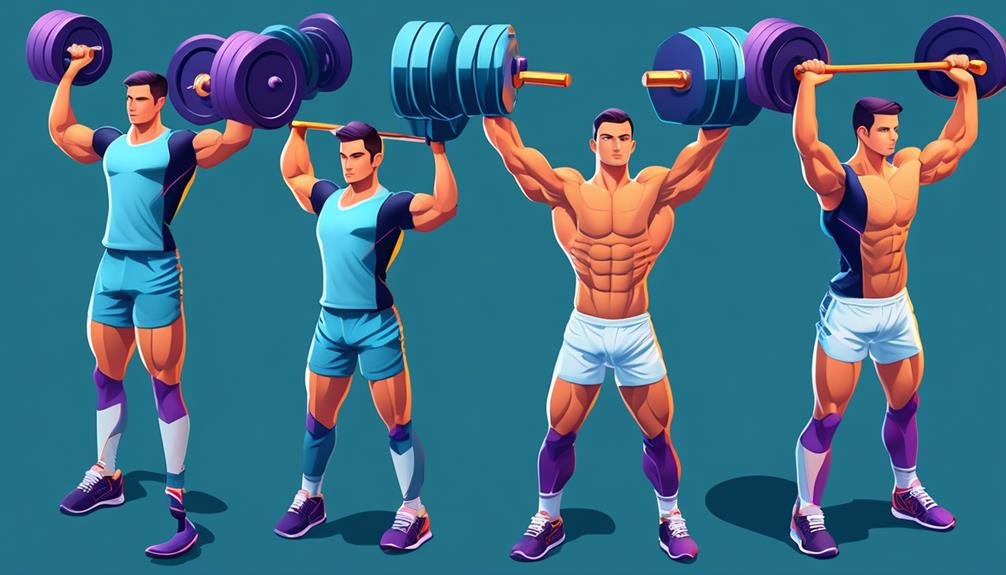You may be wondering if it's possible to safely lift dumbbells to your shoulders without a spotter. While having a spotter is always ideal, there are precautions you can take to ensure your safety when working out alone.
In this discussion, we will explore some effective techniques and strategies that will allow you to confidently lift dumbbells to your shoulders without the need for a spotter. By following these guidelines, you'll be able to maximize your workout and achieve your fitness goals with peace of mind.
So, let's dive in and discover the key to safely lifting dumbbells to your shoulders solo.
Key Takeaways
- Proper warm-up and stretching are essential before lifting dumbbells to your shoulders
- Beginners should start with lighter weights and gradually increase as they progress
- Maintaining proper form and technique is crucial to prevent strain and injury
- Alternative exercises can be used to target the shoulders without a spotter
Proper Warm-Up and Stretching
To safely prepare your body for lifting dumbbells to your shoulders, it's crucial to properly warm up and stretch your muscles. Before you start your workout, spend at least 5-10 minutes engaging in some light cardiovascular activity, such as jogging or cycling, to increase blood flow and raise your body temperature. This will help to loosen up your muscles and prepare them for the upcoming workout.
After your cardiovascular warm-up, it's time to focus on stretching. Begin with dynamic stretches, which involve moving parts of your body through a full range of motion. Examples include arm circles, leg swings, and torso twists. These stretches help to improve flexibility and range of motion.
Next, move on to static stretches, where you hold a stretch for about 20-30 seconds without bouncing. Focus on stretching the muscles that will be engaged during your dumbbell shoulder exercises, such as your shoulders, chest, and arms.
Selecting the Right Dumbbell Weight
Choose the appropriate dumbbell weight to ensure a safe and effective shoulder workout. Selecting the right weight is crucial to prevent injuries and achieve the desired results. Start by assessing your current strength level and fitness goals. If you're a beginner or returning to exercise after a break, start with lighter weights to allow your muscles to adapt and minimize the risk of strain. As you progress, gradually increase the weight to maintain a challenging workout.
To determine the appropriate weight, consider your comfort level and the number of repetitions you can perform with proper form. If you can easily complete the set without feeling fatigued, the weight may be too light. On the other hand, if you struggle to complete the set with proper form, the weight may be too heavy. Aim for a weight that allows you to perform 8-12 repetitions while maintaining proper technique. This range promotes muscle growth and strength development.
Maintaining Proper Form and Technique

Maintain proper form and technique while lifting dumbbells to shoulders to maximize the effectiveness of your workout and minimize the risk of injury. Start by standing with your feet shoulder-width apart and a slight bend in your knees. Hold the dumbbells with an overhand grip, palms facing inward. Engage your core and keep your back straight throughout the exercise.
To lift the dumbbells, begin by bending your elbows and bringing the weights up towards your shoulders. Keep your elbows close to your body and avoid swinging or jerking the weights. Lift the dumbbells in a controlled manner, focusing on using your shoulder muscles to perform the movement.
As you lift, exhale and contract your shoulders at the top of the movement. Pause briefly before slowly lowering the dumbbells back to the starting position, inhaling as you do so. Maintain a slow and controlled pace throughout the exercise, avoiding any sudden or rapid movements.
Remember to keep your shoulders relaxed and avoid shrugging them up towards your ears. Keep your neck aligned with your spine and avoid straining your neck or back. If you feel any pain or discomfort, stop the exercise and reassess your form.
Using Alternative Exercises and Modifications
Consider incorporating different exercises and modifications to target the shoulders effectively and prevent workout monotony.
If you don't have a spotter to safely lift dumbbells to your shoulders, there are alternative exercises you can try. One option is the dumbbell front raise, where you hold a dumbbell in each hand with palms facing your thighs. Slowly lift the dumbbells in front of you, keeping your arms straight and parallel to the floor.
Another exercise is the dumbbell lateral raise, where you hold a dumbbell in each hand with palms facing your thighs. Lift the dumbbells out to the sides until your arms are parallel to the floor.
Additionally, you can perform the seated dumbbell press. Sit on a bench with a dumbbell in each hand, and press the dumbbells up overhead, extending your arms fully.
Remember to start with a weight that challenges you but allows you to maintain proper form. With these alternative exercises, you can safely target your shoulders without the need for a spotter.
Make sure to adjust the weight and repetitions based on your fitness level and goals.
Safety Precautions and Tips for Solo Lifting

To ensure your safety while lifting dumbbells solo, it's essential to follow proper safety precautions and tips. Here are four important guidelines to keep in mind:
- Start with lighter weights: When lifting without a spotter, it's crucial to choose a weight that you can comfortably handle. Begin with lighter dumbbells to ensure that you maintain proper form and reduce the risk of injury.
- Maintain proper form: Proper form is vital to prevent straining your muscles or injuring yourself. Keep your back straight, engage your core, and lift the dumbbells using controlled movements. Avoid jerking or swinging the weights, as this can put excessive strain on your joints.
- Use a stable and secure surface: Always perform your dumbbell exercises on a stable and non-slip surface. Avoid uneven or slippery floors that could cause you to lose your balance. Additionally, make sure the surface is clear of any obstacles that may interfere with your movements.
- Be mindful of fatigue: Pay attention to your body's signals and listen to your limits. Overexerting yourself can lead to muscle fatigue, which increases the risk of injury. If you start to feel excessively fatigued or experience pain, it's important to stop and rest.
Frequently Asked Questions
Can I Use Resistance Bands Instead of Dumbbells for Shoulder Exercises?
You can definitely use resistance bands instead of dumbbells for shoulder exercises. They provide similar resistance and can be a safer option when lifting without a spotter. Just make sure to choose the right level of resistance for your fitness level.
How Many Sets and Reps Should I Do When Lifting Dumbbells to My Shoulders?
To safely lift dumbbells to your shoulders without a spotter, start by standing with your feet shoulder-width apart. Engage your core, bend your knees slightly, and lift the dumbbells using your biceps.
Should I Perform These Exercises Standing or Sitting?
To safely lift dumbbells to your shoulders without a spotter, it is recommended to perform the exercises standing. This allows for better stability and control of the weights, reducing the risk of injury.
Are There Any Specific Breathing Techniques I Should Follow During the Exercise?
When lifting dumbbells to your shoulders without a spotter, it's important to maintain control and use proper form. Exhale as you lift the weights, inhale as you lower them, and engage your core for stability.
Is It Necessary to Wear Wrist Wraps or Other Protective Gear While Lifting Dumbbells to My Shoulders?
No, it's not necessary to wear wrist wraps or other protective gear while lifting dumbbells to your shoulders. However, it's always a good idea to consult with a fitness professional to ensure proper form and safety.
Conclusion
In conclusion, lifting dumbbells to your shoulders without a spotter can be done safely by following a few key steps.
Start with a proper warm-up and stretch, choose the right dumbbell weight for your fitness level, and maintain proper form and technique throughout the exercise.
If you feel uncomfortable or unsure, consider using alternative exercises or modifications.
Always prioritize safety by listening to your body and taking necessary precautions.
Happy lifting!





